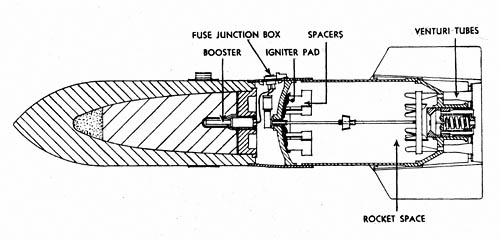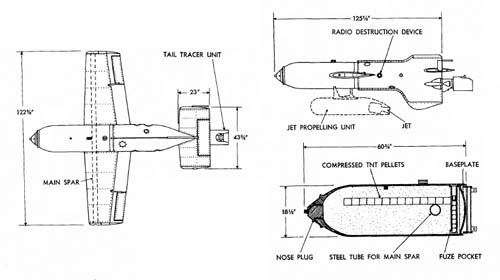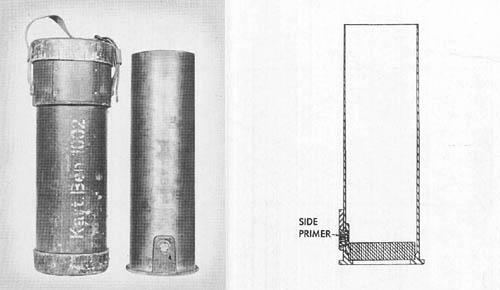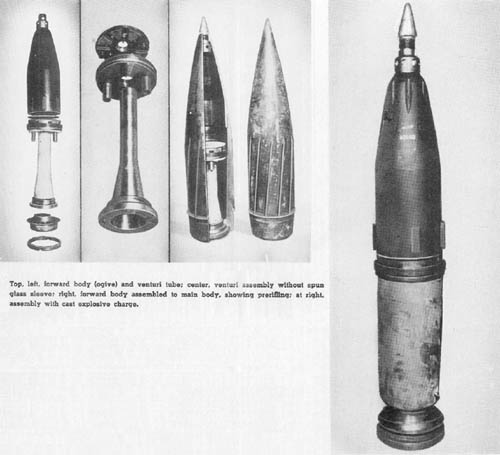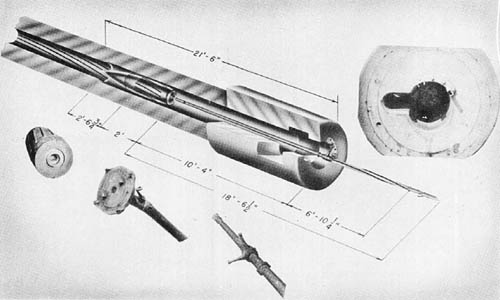
Indexing and ramming the 28 cm prerifled projectile in the German railway gun, 28 cm K5 (E), is accomplished with the aid of the rammer which, by gripping the base of the shell, allows the projectile to be indexed during its final travel through the powder chamber. Fitted centrally in the flat head of the rammer are two claws, reversed to each other and held outwardly by spring tension. A circular undercut recess in the base of the projectile receives these two claws holding the base of the shell against the face of the rammer. Two keyways milled in the periphery of the base of the shell receive corresponding, lugs on the face of the rammer and hold the members in rotation. Four evenly spaced lugs projecting longitudinally from the face of the rammer fit over the sides of the base of the projectile and hold the two in a transverse direction.
The head is fitted by a universal joint to the rammer, the front portion of which is a plain two-inch shaft approximately ten feet long and the rear portion machined with four longitudinal splines set at the same angle as the rifling of the tube. Over the splined portion of the rammer, which is 6 feet, 10/4 inches long, slides a collar fitted with two radially projecting horns set at approximately 75 degrees. The last 16 1/4 inches of the rammer are not splined and the extremity threaded, in all probability to receive a transverse handle. A lever which depresses the claws to release the head from the base of the projectile is fitted to the rear portion of the shaft.
A bracket bolted in the rear face of the breech ring has the function of receiving in two longitudinal keyways, the extremities of the two radial horns of the sliding collar.
In operation, the rammer is held securely to the base of the projectile and the shell is rammed through the powder chamber until the two horns of the sliding collar, in its forward position along the splines, engage in the two matching keyways of the bracket fitted to the rear of the breech ring. At this point, the shell, which still has approximately 2 feet, 6 3/4 inches to travel before the leading edge of the splines engage in the grooves of the rifling, is indexed and during the remaining forward travel of ramming remains indexed by virtue of the sliding collar which being held against rotation causes the rammer sliding through it to rotate at the same twist as the rifling.
The position of the two horns can be adjusted in relation to the body of the collar and once set for a particular gun, no further adjustments are necessary. A scale etched on the spline portion of the rammer indicates the depth of ramming from 2,850 to 4,050 centimeters for the 28 cm K5 (E).
German: p. 312.2 (June 1, 1945)
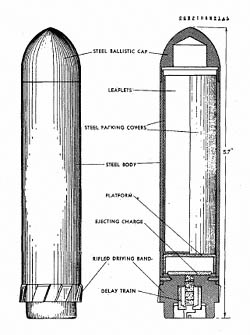 This grenade which is used for propaganda purposes consists of a cylindrical steel body with a pre-rifled base and a removable ballistic cap. The base of the grenade contains a 9-second delay fuze and an ejecting charge covered by a cardboard disc to prevent moisture from causing deterioration. Leaflets are inserted in two steel packing covers held loosely inside the case, and then the case and cap are varnished to protect them from rust. On firing, the flash from the propelling cartridge ignites the fuze and approximately 9 seconds later the ejecting charge explodes, blowing off the cap and forcing the leaflets out of the nose of the projectile.
This grenade which is used for propaganda purposes consists of a cylindrical steel body with a pre-rifled base and a removable ballistic cap. The base of the grenade contains a 9-second delay fuze and an ejecting charge covered by a cardboard disc to prevent moisture from causing deterioration. Leaflets are inserted in two steel packing covers held loosely inside the case, and then the case and cap are varnished to protect them from rust. On firing, the flash from the propelling cartridge ignites the fuze and approximately 9 seconds later the ejecting charge explodes, blowing off the cap and forcing the leaflets out of the nose of the projectile.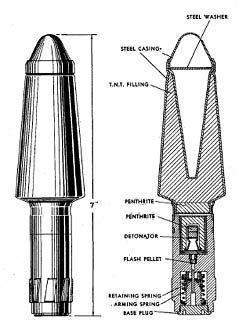 This grenade, while larger and of slightly different contour than that described on the preceding page, is basically the same in construction and operation. The body of pressed steel contains a steel cone around which the T.N.T. filler is cast, and at the bottom of the filler is an exploder pellet of penthrite wax. Two types of stem may be used, one entirely of light alloy and the other of plastic with a steel shank by which it is screwed onto the body. The booster assembly and the percussion type fuze are both located in the stem divided by a perforated septum which contains a small flash pellet. At the base of the stem is a rifled band which corresponds to the rifling on the discharger. The assembly is closed by a base plug.
This grenade, while larger and of slightly different contour than that described on the preceding page, is basically the same in construction and operation. The body of pressed steel contains a steel cone around which the T.N.T. filler is cast, and at the bottom of the filler is an exploder pellet of penthrite wax. Two types of stem may be used, one entirely of light alloy and the other of plastic with a steel shank by which it is screwed onto the body. The booster assembly and the percussion type fuze are both located in the stem divided by a perforated septum which contains a small flash pellet. At the base of the stem is a rifled band which corresponds to the rifling on the discharger. The assembly is closed by a base plug.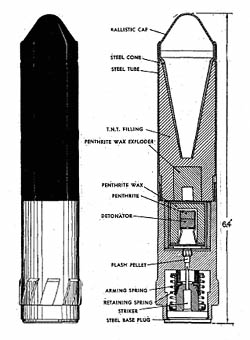 The Gewehr Panzergranate is constructed in two parts, the head and the stem. The head, a seamless steel tube fitted with a light ballistic cap, contains a hollow charge cone and an explosive filling of T.N.T. A cavity is provided in the rear portion of the main filling to take an exploder of penthrite wax. The stem of light alloy or aluminum is screwed onto the head of the grenade. It is divided into two compartments. The upper portion contains the booster which consists of a detonator surrounded by a penthrite wax filling contained in a light alloy case. The percussion type fuze is located in the lower part of the stem. In the septum is a small flash pellet held in place by a perforated screw plug. A pre-engraved driving band is formed on the outside of the grenade approximately 1/4 inch fromn the base. The entire assembly is closed by a base plug which positions the fuze by a stem which fits into a recess in the rear of the striker body.
The Gewehr Panzergranate is constructed in two parts, the head and the stem. The head, a seamless steel tube fitted with a light ballistic cap, contains a hollow charge cone and an explosive filling of T.N.T. A cavity is provided in the rear portion of the main filling to take an exploder of penthrite wax. The stem of light alloy or aluminum is screwed onto the head of the grenade. It is divided into two compartments. The upper portion contains the booster which consists of a detonator surrounded by a penthrite wax filling contained in a light alloy case. The percussion type fuze is located in the lower part of the stem. In the septum is a small flash pellet held in place by a perforated screw plug. A pre-engraved driving band is formed on the outside of the grenade approximately 1/4 inch fromn the base. The entire assembly is closed by a base plug which positions the fuze by a stem which fits into a recess in the rear of the striker body.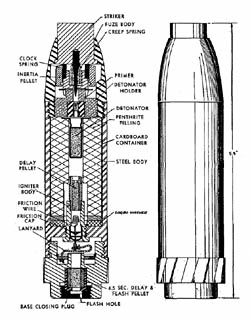 This grenade consists of a tubular steel body containing an explosive filler of penthrite wax, a detonator, a direct action nose fuze, a delay friction igniter, and a base assembly containing a self-destroying system. A diaphragm near the bottom of the grenade is threaded centrally to receive the friction igniter. The fuze and base assemblies are not integral parts of the grenade, but are screwed into the nose and base respectively. If the nose fuze does not function properly, the grenade is self-destructive. On firing, the flash from the propelling cartridge enters a hole in the base closing plug and ignites a 6.5 second delay pellet contained in a brass holder. This fires the friction igniter which, gives an additional delay of 4.5 seconds before setting off the detonator. The grenade may also be used as a hand grenade by removing the base assembly and pulling a cord attached to the friction igniter.
This grenade consists of a tubular steel body containing an explosive filler of penthrite wax, a detonator, a direct action nose fuze, a delay friction igniter, and a base assembly containing a self-destroying system. A diaphragm near the bottom of the grenade is threaded centrally to receive the friction igniter. The fuze and base assemblies are not integral parts of the grenade, but are screwed into the nose and base respectively. If the nose fuze does not function properly, the grenade is self-destructive. On firing, the flash from the propelling cartridge enters a hole in the base closing plug and ignites a 6.5 second delay pellet contained in a brass holder. This fires the friction igniter which, gives an additional delay of 4.5 seconds before setting off the detonator. The grenade may also be used as a hand grenade by removing the base assembly and pulling a cord attached to the friction igniter.